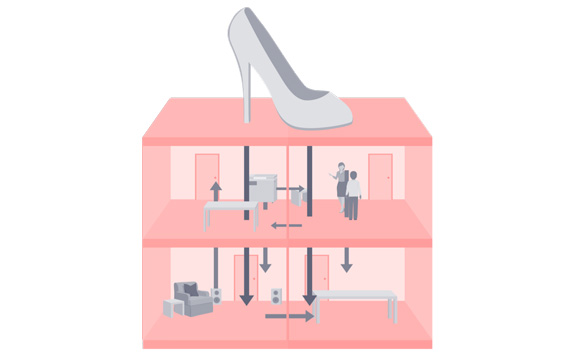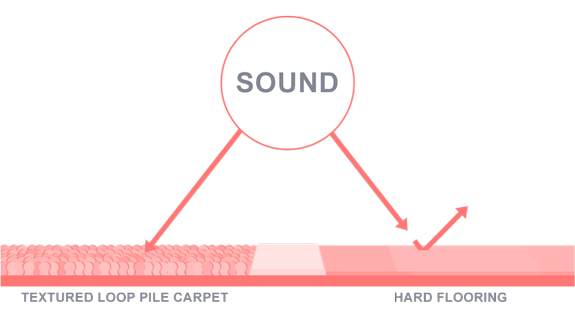Sound – especially sound in the spaces where we work – affects us far more than you might think. When it comes to designing interior spaces, acoustic considerations are often put aside or completely ignored in favour of purely visual aesthetics. However, condemning office workers, hospital staff, students and teachers, guests in hotels and even people in their homes to bad acoustics and the resulting high noise levels is simply unacceptable. This is because noise adversely affects well-being, effectiveness and happiness.
Understanding how sound affects human health is vital for architects and interior designers. Likewise, knowing how to measure sound and apply acoustic standards, will help designers and industry to transform how we feel about and respond to the spaces we inhabit.
Measuring Sound
When airborne sound meets a physical barrier, the barrier will have any or all of three effects on the sound.

Reflect
Reflection is when sound bounces off a surface back into the room. Hard surfaces reflect more sound than soft ones, so rooms with mainly hard surfaces tend to be louder.
The sum of all the reflections in a room is called reverberation. Large spaces with hard surfaces have long reverberation time (RT), which is the time it takes for a sudden sound to die away. Where good speech intelligibility matters, as in a classroom or a meeting room, RT should ideally be under half a second. In most social spaces (including open plan offices), it should be well under one second.
Absorb
Absorption is when sound energy is transformed into heat energy – usually by a soft surface – and disappears. The absorbency of a material is noted with a number between 0 and 1, where 0 is complete reflection and 1 is complete absorption.
Two measurements for absorption which are similar but not directly comparable are the US-based sound absorption average (SAA) and the increasingly universal weighted sound absorption coefficient (αw aka Alpha-w). For simplicity, the International Standards Organisation has created sound absorption class (SAC), which groups Alpha-w’s into brands from A (most absorbent) to E (least absorbent).
Transmit
Transmission happens when sound passes through a surface and can be heard on the other side. Most surfaces will reflect or absorb some sound, so not all the sound reaches the other side; this reduction is called attenuation. Attenuation of 10 dB means that sound seems half as loud on the other side.

How sound is transmitted in buildings
The US measure of attenuation for airborne sound is called sound transmission class (STC) while the international measure is Rw. Both are dB averages of attenuation across a range of frequencies in dB.
A Sound Standard
While the above sound measurements are helpful for assessing the acoustical properties of a product, they are calculated in laboratories and can be wrongly interpreted when it comes to complex, real-world installations. That’s why a standard for noise performance in practical real-world applications can be very helpful – which is exactly what Quiet Mark sets out to achieve.
Quiet Mark is the international award program for recognising excellence in low-noise technology and in solutions to unwanted noise. Associated with the U.K. Noise Abatement Society, Quiet Mark encourages companies worldwide to prioritise noise reduction within the design of everyday products, machines and appliances, giving consumers and industry alike a trusted mark of approval that can help transform the aural environment for the benefit of all. Companies with Quiet Mark-certified products include Dyson, Whirlpool and Bosch.
What differentiates Quiet Mark from other standards of sound measurement is that consumer products are tested in the environment where they’ll be used. For example, lawnmowers will be tested outdoors, dishwashers will be tested in a kitchen and vacuum cleaners will be used on a range of different surfaces. And because acoustic design is constantly advancing, Quiet Mark annually re-evaluates the products bearing its label.
Managing Noise with Flooring
One of the best ways to mitigate the effect of noise in indoor environments is through flooring. With carpet this is obvious because we intuitively know that soft surfaces are quieter.

However, hard flooring is catching up as both an aesthetically pleasing and acoustically effective option. Even Interface’s fashionable LVT performs acoustically very well with its Sound ChoiceTM backing.
Lesson learnt: Any floor can look great and improve acoustics at the same time.